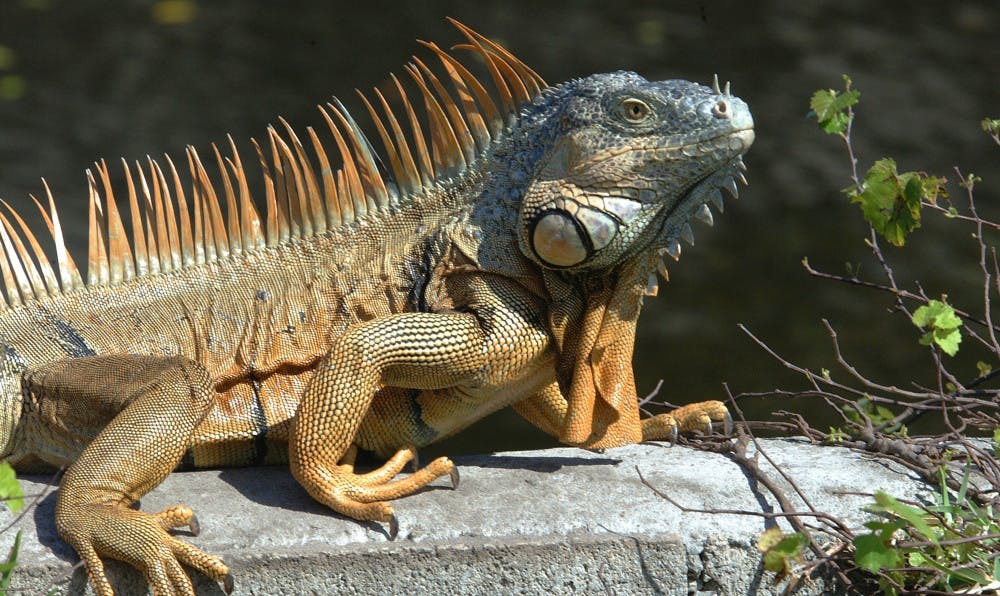Iguanas ran rampant in South Florida this summer, so much so the state’s Fish & Wildlife Commission urged residents to kill them.
Two UF Institute of Food and Agricultural Sciences professors came up with a solution to get rid of the dead iguanas: eat them.
Professors William Kern and Frank Mazzotti believe people can be more environmentally efficient by eating iguana meat, rather than throwing the carcass away after killing it.
Iguana meat is a delicacy in Central and South American cultures, Kern said. Most of the meat comes from the legs and panels of muscle on either side of the spine. He calls it a very mild flavor.
“It reminds me of alligator ribs," Kern said. “It’s very gamey. The closest thing would be turtle meat.”
The meat can be incorporated into recipes in various ways. A large iguana can feed 10 people if made into a soup, Kern said. In addition to using the meat of the iguana, fertilized eggs can be eaten as well.
“Some people just clean them and put them on the grill,” Kern said. “As you pull the vertebrae apart, you can eat the meat off.”
However, food safety is a concern when handling iguana meat. Kern said most of the bacteria is found in the gut of the animal. Proper disinfection and cooking methods minimize the risk of infection to nearly nothing.
“As long as you’re really careful with how you dress the meat, the danger of things like salmonella and E. coli is going to be much less likely,” Kern said.
Brenda Marty-Jimenez, a UF Family and Consumer Sciences extension agent in Broward County, also emphasized the importance of food safety when it comes to handling any reptile meat.
Another concern holding people back from trying iguana is how foreign the food may appear to the traditional American palette, she said.
“If you open up your mind a little bit and season and cook them properly, it can be a really delicious protein alternative,” Marty-Jimenez said.
Since the 1970s, iguanas have been a problem as an invasive species in South Florida. In 2010, the iguana population reached its highest point at 500,000 to a million, Kern said. However, cold temperatures then caused the population size to drop suddenly. In the past 10 years, rising temperatures have allowed iguanas to thrive and breed, returning their numbers to 2010 peak levels and proving a threat to the natural ecosystem.
Most are brought from countries like Venezuela and Brazil to be sold as pets only to be later released into the ecosystem. Iguanas don’t have any natural predators in South Florida, so they throw the natural habitat off balance by eating too many insects and animals.
“That little baby iguana that a child brings home from the pet store, that’s gonna be around for a long time,” Kern said. “When people finally decide, ‘Well, the kids have gone to college and we don’t want to take care of this thing anymore,’ the problem starts.”
Under Florida law, iguanas are considered a non-native species and are allowed to be hunted humanely.
People who want to eat iguanas have to hunt them or get them near the Everglades. Even though iguana nuggets won’t be in local supermarkets anytime soon, Kern still makes do. He said he makes a really mean iguana curry.
“It’s very well suited to things like curries and gumbos,” Kern said. “The best way I've done is to make a curry with lots of vegetables. That spreads the meat out.”
Brenda Marty-Jimenez’s recipe for iguana tacos and burritos, adapted from Brittney Peters receipe in the July 29, 2018, Sun Sentinel.
Iguana Tacos/Burritos
Ingredients:
- Iguana meat (cooked and cut into small pieces)
- Onion
- Chives
- Avocado
- Lime
- Chili-lime seasoning
- Curry or taco seasoning
- Sour cream
- Salsa
- Flour tortillas
Directions:
- Wash the iguana meat thoroughly after removing the skin, organs and entrails, so that just the meat and cartilage remain.
- Put the iguana meat in boiling water. Add onions to the water for flavor. Let cook for at least an hour or longer, until tender.
- Remove the tender meat from the cartilage. Cut into small pieces, separating the white and dark meat, then season with whichever type of seasoning you enjoy in tacos/burritos.
- Season the white meat with chili-lime seasoning, curry or any other type of taco-type spice.
- Chop onions and chives, avocado, limes and other desired toppings.
- Mix the onions and chives in with the meat. Then, sauté the mixture on medium-high heat until it is soft.
- Place the meat in the center of a flour tortilla with avocado, sour cream, salsa and other toppings.
- Wrap and enjoy.
Reference: Sun Sentinel; Adapted from Brittany Peters recipe—July 2018
Iguana.





![Photo of the missing Leachianus “Leachie” gecko. [Photo courtesy of Mike Southwick]](https://snworksceo.imgix.net/ufa/907bd92a-0b29-40eb-a5fb-d7db7cf98b2f.sized-1000x1000.jpg?w=1500&ar=16%3A9&fit=crop&crop=faces&facepad=3&auto=format)
